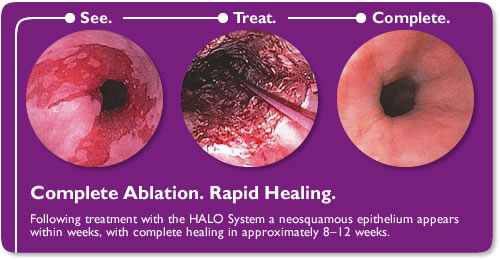|
New Treatment for Barrett’s EsophagusPaul Ruh, MD Barrett’s Esophagus (Barrett’s) is a condition best described as a change in the type of tissue that lines the esophagus. It occurs most commonly in people that have gastroesophageal reflux disease (GERD). Heartburn is the primary symptom experienced in patients with GERD. The most important concern about Barrett’s esophagus is that it greatly increases one’s chance of developing esophageal cancer. Most concerning is the fact that for reason’s not understood, the number of new esophageal cancer cases is rising at an alarming rate in western countries. Although not all patients with GERD will develop Barrett’s, it is recommended that all patients be screened for it after having symptoms for a significant period of time. The screening is done with an upper endoscopy otherwise known as an EGD (esophagogastroduodenoscopy). During an EGD the endoscopist looks for abnormal tissue appearance and may take tissue samples through the endoscope to confirm the diagnosis of Barrett’s Esophagus. The biopsies might also show changes indicating the tissue is beginning to act like cancer tissue, a condition referred For decades, the gastroenterology and surgical communities have been trying to develop safe and effective methods to eradicate Barrett’s Esophagus, especially in patients who have developed the higher risk dysplasia. In some cases, this required surgical resection of the esophagus which is an involved surgery and can be risky in the older patients in whom we often find the dysplasia. Methods of eradication using the endoscope have been tried with some success, but they have had quite high complication rates or weren’t very effective at “getting rid of” all the abnormal tissue. The risks include narrowing caused from excessive scarring, bleeding and most importantly perforation which is when a hole is inadvertently made through the wall of the esophagus. A newer much safer approach to “cure” Barrett’s Esophagus has been used in recent years called radiofrequency ablation. This method uses high frequency radio waves to damage and subsequently remove the inside layer of esophageal tissue. The normal esophageal tissue then grows back into the treated area. The depth of penetration of energy from the radio waves is very controlled and therefore the complication rates are much lower than the previous procedures. Initially, this and other methods of eliminating the Barrett’s was only used in patients with the highest risk of developing cancer (those with dysplasia), but now experts have recommended treatment in all patients with Barrett’s. White males have the highest risk of developing esophageal cancer, even if they don’t have dysplasia when we first diagnose the Barrett’s. Therefore it is recommended that they will benefit most from treatment.
Radiofrequency ablation is performed as part of an EGD procedure and the patient’s experience will be almost identical. The ablation is done as part of a series and usually requires three to five procedures separated by three months to complete. Once the ablation is completed, the risk of Barrett’s returning and therefore the risk of cancer is greatly reduced. The decision to have this treatment should be made in consultation with your doctor and your gastroenterologist.
Dr. Paul Ruh – Eau Claire GI Associates |



